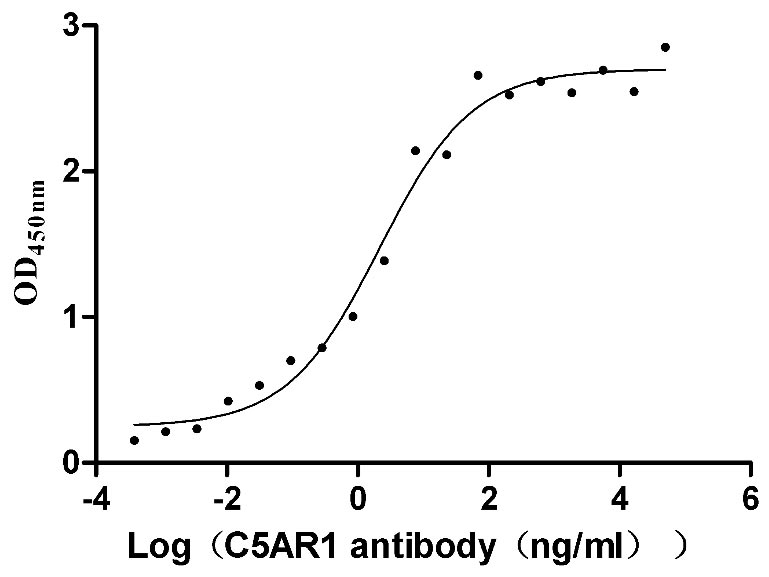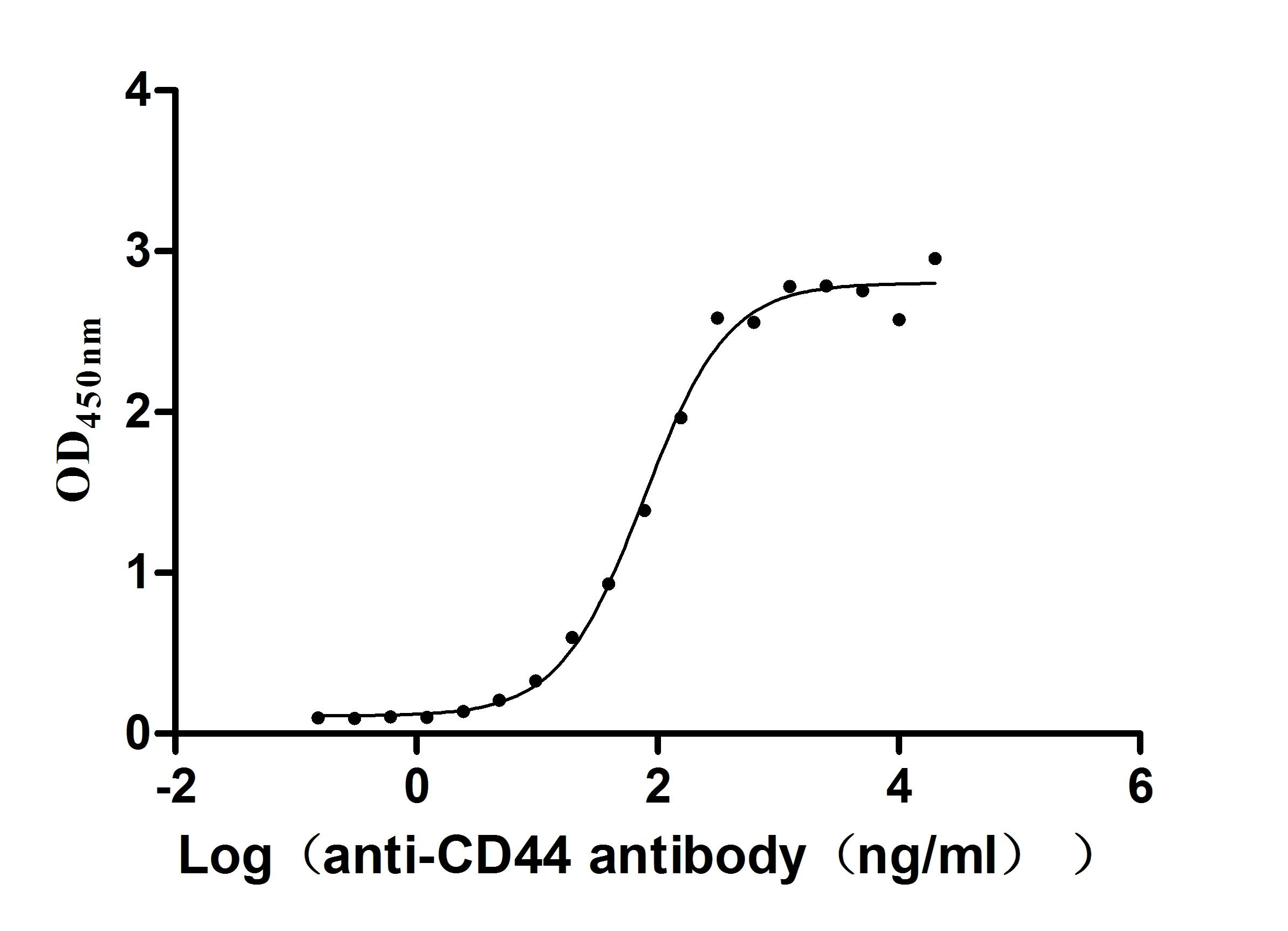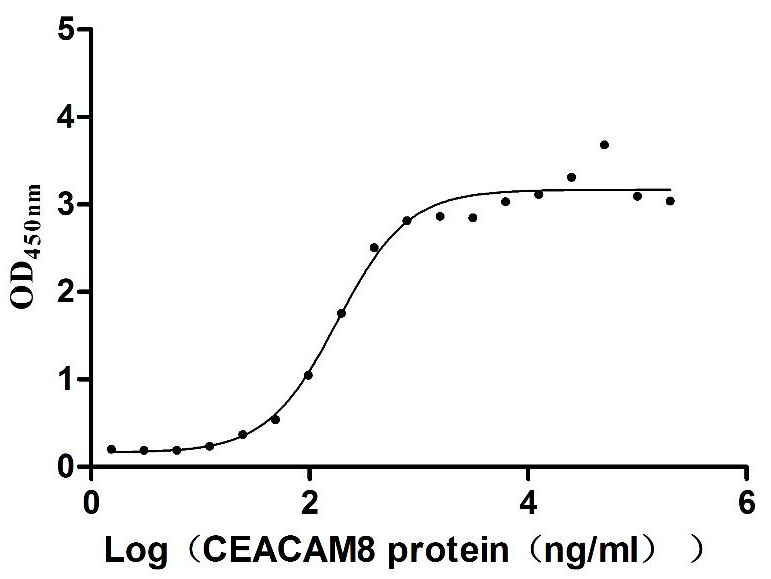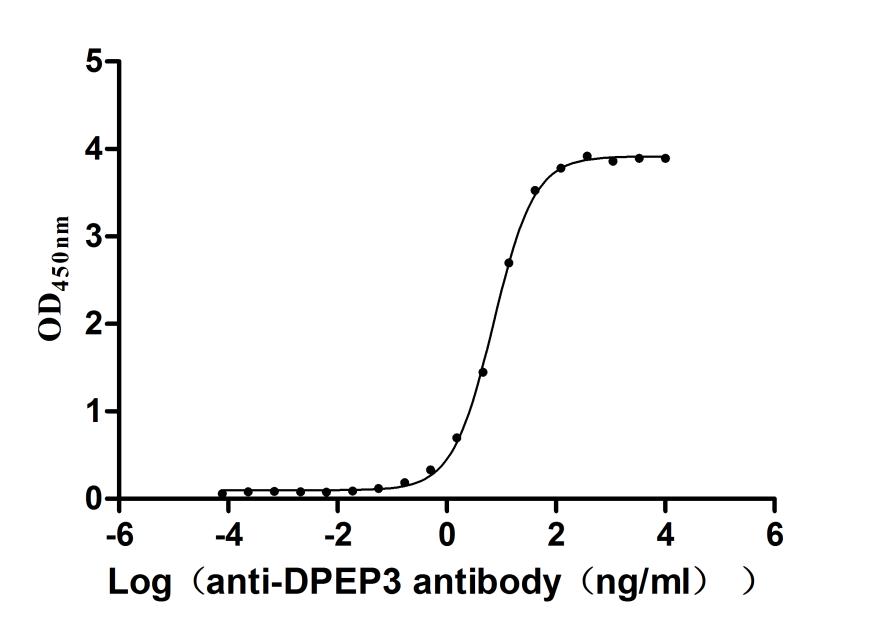Recombinant Mouse Peroxisome proliferator-activated receptor alpha (Ppara)
-
中文名稱(chēng):小鼠Ppara重組蛋白
-
貨號(hào):CSB-YP018421MO
-
規(guī)格:
-
來(lái)源:Yeast
-
其他:
-
中文名稱(chēng):小鼠Ppara重組蛋白
-
貨號(hào):CSB-EP018421MO
-
規(guī)格:
-
來(lái)源:E.coli
-
其他:
-
中文名稱(chēng):小鼠Ppara重組蛋白
-
貨號(hào):CSB-EP018421MO-B
-
規(guī)格:
-
來(lái)源:E.coli
-
共軛:Avi-tag Biotinylated
E. coli biotin ligase (BirA) is highly specific in covalently attaching biotin to the 15 amino acid AviTag peptide. This recombinant protein was biotinylated in vivo by AviTag-BirA technology, which method is BriA catalyzes amide linkage between the biotin and the specific lysine of the AviTag.
-
其他:
-
中文名稱(chēng):小鼠Ppara重組蛋白
-
貨號(hào):CSB-BP018421MO
-
規(guī)格:
-
來(lái)源:Baculovirus
-
其他:
-
中文名稱(chēng):小鼠Ppara重組蛋白
-
貨號(hào):CSB-MP018421MO
-
規(guī)格:
-
來(lái)源:Mammalian cell
-
其他:
產(chǎn)品詳情
-
純度:>85% (SDS-PAGE)
-
基因名:Ppara
-
Uniprot No.:
-
別名:Ppara; Nr1c1; Ppar; Peroxisome proliferator-activated receptor alpha; PPAR-alpha; Nuclear receptor subfamily 1 group C member 1
-
種屬:Mus musculus (Mouse)
-
蛋白長(zhǎng)度:Full length protein
-
表達(dá)區(qū)域:1-468
-
氨基酸序列MVDTESPICP LSPLEADDLE SPLSEEFLQE MGNIQEISQS IGEESSGSFG FADYQYLGSC PGSEGSVITD TLSPASSPSS VSCPVIPAST DESPGSALNI ECRICGDKAS GYHYGVHACE GCKGFFRRTI RLKLVYDKCD RSCKIQKKNR NKCQYCRFHK CLSVGMSHNA IRFGRMPRSE KAKLKAEILT CEHDLKDSET ADLKSLGKRI HEAYLKNFNM NKVKARVILA GKTSNNPPFV IHDMETLCMA EKTLVAKMVA NGVEDKEAEV RFFHCCQCMS VETVTELTEF AKAIPGFANL DLNDQVTLLK YGVYEAIFTM LSSLMNKDGM LIAYGNGFIT REFLKNLRKP FCDIMEPKFD FAMKFNALEL DDSDISLFVA AIICCGDRPG LLNIGYIEKL QEGIVHVLKL HLQSNHPDDT FLFPKLLQKM VDLRQLVTEH AQLVQVIKKT ESDAALHPLL QEIYRDMY
-
蛋白標(biāo)簽:Tag?type?will?be?determined?during?the?manufacturing?process.
The tag type will be determined during production process. If you have specified tag type, please tell us and we will develop the specified tag preferentially. -
產(chǎn)品提供形式:Lyophilized powder
Note: We will preferentially ship the format that we have in stock, however, if you have any special requirement for the format, please remark your requirement when placing the order, we will prepare according to your demand. -
復(fù)溶:We recommend that this vial be briefly centrifuged prior to opening to bring the contents to the bottom. Please reconstitute protein in deionized sterile water to a concentration of 0.1-1.0 mg/mL.We recommend to add 5-50% of glycerol (final concentration) and aliquot for long-term storage at -20℃/-80℃. Our default final concentration of glycerol is 50%. Customers could use it as reference.
-
儲(chǔ)存條件:Store at -20°C/-80°C upon receipt, aliquoting is necessary for mutiple use. Avoid repeated freeze-thaw cycles.
-
保質(zhì)期:The shelf life is related to many factors, storage state, buffer ingredients, storage temperature and the stability of the protein itself.
Generally, the shelf life of liquid form is 6 months at -20°C/-80°C. The shelf life of lyophilized form is 12 months at -20°C/-80°C. -
貨期:Delivery time may differ from different purchasing way or location, please kindly consult your local distributors for specific delivery time.Note: All of our proteins are default shipped with normal blue ice packs, if you request to ship with dry ice, please communicate with us in advance and extra fees will be charged.
-
注意事項(xiàng):Repeated freezing and thawing is not recommended. Store working aliquots at 4°C for up to one week.
-
Datasheet :Please contact us to get it.
靶點(diǎn)詳情
-
功能:Ligand-activated transcription factor. Key regulator of lipid metabolism. Activated by the endogenous ligand 1-palmitoyl-2-oleoyl-sn-glycerol-3-phosphocholine (16:0/18:1-GPC). Activated by oleylethanolamide, a naturally occurring lipid that regulates satiety. Receptor for peroxisome proliferators such as hypolipidemic drugs and fatty acids. Regulates the peroxisomal beta-oxidation pathway of fatty acids. Functions as transcription activator for the ACOX1 and P450 genes. Transactivation activity requires heterodimerization with RXRA and is antagonized by NR2C2. May be required for the propagation of clock information to metabolic pathways regulated by PER2.
-
基因功能參考文獻(xiàn):
- For the first time, we report here the importance of GPER-PPARalpha and -PPARgamma 'neopartnership' in maintenance of Leydig cell morpho-functional status. PMID: 30149370
- Integrated transcriptomics and proteomics data predicted the activation of TGF beta and inactivation of PPAR alpha signaling pathways in mouse heart tissue 40 weeks after local radiation exposure (16 Gy). This study strongly suggests a crosstalk between the two pathways via MAPK signaling. PMID: 27805817
- The study suggests that persistent alteration of cardiac metabolism due to impaired PPAR alpha activity contributes to the heart pathology after radiation.Ionizing radiation markedly changed the phosphorylation and ubiquitination status of PPAR alpha. This was reflected as decreased expression of its target genes involved in energy metabolism and mitochondrial respiratory chain. PMID: 23560462
- These results indicate that wistin could suppress lipid accumulation through PPARalpha activation. The action of wistin on PPARalpha could be of interest for the amelioration of lipid metabolic disorders. PMID: 29318455
- These data may indicate that insulin resistance in Adp(-/-) mice is likely caused by an increase in concentrations of TNFalpha and FFA via downregulation of PPARalpha. PMID: 29445073
- Results from transcriptional and epigenomic analyses in the livers of mice fed either a high-fat diet or nutrition-restricted diet, found extensive binding of PPARalpha near genes involved in glycolysis/gluconeogenesis and uncovered a role for this factor in regulating anaerobic glycolysis. PMID: 28282965
- Peroxisome proliferator-activated receptor alpha (PPARalpha) target gene expression was almost absent in contrast to increased lipid synthesis in the TIS21 protein (TIS21) knockout (TIS21-KO) mice compared to WT mice. PMID: 29385670
- Clofibrate treatment revealed an essential role of PPARalpha in regulating hepatic bile acid synthesis, transport and signaling. PMID: 28973556
- The authors identify an endogenous role for PPARalpha in retinal neuronal survival and lipid metabolism, and furthermore underscore the importance of fatty acid oxidation in photoreceptor survival. They also suggest PPARalpha as a putative therapeutic target for age-related macular degeneration, which may be due in part to decreased mitochondrial efficiency and subsequent energetic deficits PMID: 29183319
- p21 plays a relevant role in fasting adaptation through the positive regulation of PPARalpha. PMID: 27721423
- PPARalpha is required for the ChREBP-induced glucose response of FGF21. Loss of PPARalpha impairs Fgf21 promoter accessibility at the carbohydrate-responsive element . PMID: 29020627
- Data, including data from studies in knockout mice, suggest that hepatic induction of cytochrome P450s (Cyp3a, Cyp2b, and Cyp2c) by hypolipidemic agent gemfibrozil is suppressed by Ppara activation. PMID: 28374976
- We demonstrated that PPARalpha activation contributes to liver protection and decreases liver inflammation in acute liver failue (ALF), particularly through regulating CHOP. Our findings may provide a rationale for targeting PPARalpha as a potential therapeutic strategy to ameliorate ALF. PMID: 28600667
- These findings indicate that PPARalpha promotes osteogenic differentiation via the Sirt1-dependent signaling pathway. PMID: 28614912
- CD36 is essential for endurance improvement, changes in whole-body metabolism, and efficient peroxisome-proliferator activated receptors (PPAR)-related transcriptional responses in the muscle with exercise training. PMID: 28526781
- In mice, the oral administration of linalool for 3 weeks reduced plasma TG concentrations in Western-diet-fed C57BL/6J mice (31%, P < 0.05) and human apo E2 mice (50%, P < 0.05) and regulated hepatic PPARalpha target genes. PMID: 24752549
- a novel PPARalpha-dependent gene PMID: 28442498
- fenofibrate upregulated VLDLR transcriptional activity through PPAR response element binding to the VLDLR promoter. PMID: 24899625
- PPARalpha activation contributes to liver protection and decreases hepatocyte apoptosis in acute liver failure, particularly through regulating endoplasmic reticulum stress. PMID: 27482818
- These results suggest that HCVcp-induced age-dependent PPARalpha activation increases synthesis of sulfatides and the resulting sulfatide accumulation affects HCV-related liver cancer. PMID: 27318478
- These findings suggested that PPARalpha activation in adipose tissue contributes to the improvement of glucose metabolism disorders via the enhancement of BCAA and FFA metabolism. PMID: 28919422
- Hepatic PARP1 activation inhibits FAO pathway upregulation through poly(ADP-ribosyl)ation of PPARalpha, worsening hepatic steatosis and inflammatory responses associated with overnutrition. PMID: 27979751
- TGF-beta and PPARalpha signaling pathways are involved in radiation-induced heart fibrosis, metabolic dysregulation, and impaired heart contractility, a pathophysiological condition that is often observed in patients that received high radiation doses in thorax. PMID: 27805817
- This study identifies an endocrine developmental axis in which fetal GR primes the activity of PPARalpha in anticipation of the sudden shifts in postnatal nutrient source and metabolic demands. PMID: 27367842
- findings identify a new important innate immune function for the PPARalpha signaling pathway in regulating intestinal inflammation, mucosal immunity, and commensal homeostasis PMID: 27183583
- our data indicate that PPAR-alpha mediates antimicrobial responses to mycobacterial infection by inducing TFEB and lipid catabolism. PMID: 28275133
- adiponectin inhibited endoplasmic reticulum stress and apoptosis of adipocyte in vivo and in vitro by activating the AMPK/PPARalpha/ATF2 pathway. PMID: 27882945
- It was concluded that decreased cardiac PPARalpha expression is essential for adaptive metabolic remodeling in hypoxia, but is prevented by dietary fat. PMID: 27103577
- these results indicate that PPAR-a accelerates important pathways for the clearance of a-ClFA, and a-ClFA may, in part, accelerate its catabolism by serving as a ligand for PPAR-a PMID: 28007964
- PPARgamma controls the cancer stem cell niche PMID: 26686086
- In mice fed with a high-fat diet, palmitoleic acid supplementation stimulated the uptake of glucose in liver through activation of AMPK and FGF-21, and was dependent on PPARalpha. PMID: 27925195
- Myocardial PPARalpha is down-regulated in animals fed a high-fat diet. PMID: 27253588
- FGF21 is not critical for bone homeostasis or actions of PPARalpha and PPARgamma. PMID: 27505721
- Perfluoroalkyl acids addition to activating PPARalpha as a primary target, also have the potential to activate CAR, PPARgamma, and ERalpha as well as suppress STAT5B. PMID: 28558994
- PPARalpha and its target gene expression were significantly increased only in the kidneys of Irbe-treated WT mice. PMID: 27496805
- PPAR-alpha activation during pressure-overloaded heart failure improved myocardial function and energetics. PMID: 28011586
- These studies conclusively show that cell proliferation is mediated exclusively by PPARA activation in hepatocytes and that Kupffer cell PPARA has an important role in mediating the anti-inflammatory effects of PPARA agonists. PMID: 28082284
- PPARalpha expression supports the hyperdynamic cardiac response early in the course of sepsis and that increased fatty acid oxidation may prevent morbidity and mortality. PMID: 27881386
- the metabolic events, controlled by PPARs, occurring during neuronal precursor differentiation, the glucose and lipid metabolism was investigated. PMID: 27860527
- Phospho-AMPK is a molecular switch able to cooperate with glucocorticoid receptors and Ppar-alpha at the chromatin level, a novel adaptation mechanism to prolonged fasting. PMID: 27576532
- These data raise the possibility that ATGL deficiency could impair the renal fatty acid metabolism though inhibiting PPARalphaexpression, which may lead to lipid deposition and cell apoptosis of PCT, and finally contribute to the renal fibrosis and dysfunction PMID: 28400046
- GRbeta antagonizes the GC-induced signaling during fasting via GRalpha and the PPARalpha-FGF21 axis that reduces fat burning. Furthermore, hepatic GRbeta increases inflammation, which leads to hepatic lipid accumulation. PMID: 27784782
- These findings reveal a novel BVRA-GSKbeta-PPARalpha axis that regulates hepatic lipid metabolism and may provide unique targets for the treatment of non-alcoholic fatty liver disease. PMID: 27738106
- CYP2A5 protects against the development of alcoholic fatty liver disease, and the PPARalpha-FGF21 axis contributes to the protective effects of CYP2A5 on alcoholic fatty liver disease. PMID: 28131861
- Cyp1b1 affects external control of mouse hepatocytes, fatty acid homeostasis and signaling involving HNF4alpha and PPARalpha. PMID: 27036855
- Chronic stimulation of PPARalpha may suppress the autophagy capacity in the liver as a result of reduced content of a number of autophagy-associated proteins independent of FGF21. PMID: 28422956
- The results indicate that alterations in PGC-1a acetylation and expression level might contribute to the regulation of melanogenesis by PPARalpha and fenofibrate. PMID: 28084540
- Inhibition of adipose tissue PPARgamma prevented LipX-induced increases in adipocyte expansion and produced a glucose-intolerant phenotype PMID: 27976431
- Data, including data from knockout mice, suggest critical role for PPARalpha in endocrine disruptor-/herbicide-/2,4-dichlorophenoxyacetic acid-induced male infertility due to disruption of spermatogenesis and cholesterol/testosterone homeostasis in Leydig cells of testis. PMID: 26838045
- Inhibition of PPAR-alpha is associated with protection against doxorubicin-induced cardiotoxicity in mice, and cannabinoids can potentiate the protection by PPAR-alpha blockade. PMID: 26082188
顯示更多
收起更多
-
相關(guān)疾病:Peroxisome proliferators are a diverse group of chemicals that include hypolipidaemic drugs, herbicides and industrial plasticisers. Administration of these chemicals to rodents results in the dramatic proliferation of hepatic peroxisomes as well as liver hyperplasia.
-
亞細(xì)胞定位:Nucleus.
-
蛋白家族:Nuclear hormone receptor family, NR1 subfamily
-
組織特異性:Highly expressed in liver, kidney and heart. Very weakly expressed in brain and testis.
-
數(shù)據(jù)庫(kù)鏈接:
Most popular with customers
-
Recombinant Human B- and T-lymphocyte attenuator (BTLA), partial (Active)
Express system: Mammalian cell
Species: Homo sapiens (Human)
-
Recombinant Human C5a anaphylatoxin chemotactic receptor 1 (C5AR1)-VLPs (Active)
Express system: Mammalian cell
Species: Homo sapiens (Human)
-
Recombinant Mouse Retinol-binding protein 4 (Rbp4) (Active)
Express system: Mammalian cell
Species: Mus musculus (Mouse)
-
Recombinant Macaca fascicularis CD44 antigen (CD44), partial (Active)
Express system: Mammalian cell
Species: Macaca fascicularis (Crab-eating macaque) (Cynomolgus monkey)
-
Recombinant Human Claudin-6 (CLDN6)-VLPs, Fluorescent (Active)
Express system: Mammalian cell
Species: Homo sapiens (Human)
-
Recombinant Human Carcinoembryonic antigen-related cell adhesion molecule 6 (CEACAM6) (Active)
Express system: Mammalian cell
Species: Homo sapiens (Human)
-
Recombinant Human Dipeptidase 3(DPEP3), partial (Active)
Express system: Mammalian cell
Species: Homo sapiens (Human)






f4-AC1.jpg)












